Business and Business Environment Analysis of Iceland Foods Report
VerifiedAdded on 2021/01/02
|18
|5774
|189
Report
AI Summary
This report provides a comprehensive analysis of the business environment, focusing on Iceland Foods Limited. It begins with an introduction to the business environment, followed by an evaluation of different organizational types (public, private, and voluntary), their purposes, sizes, and scopes, with Iceland Foods used as a case study for a private organization. The report then explores the relationship between various organizational functions, such as finance, marketing, HR, and production. It proceeds to examine the positive and negative impacts of the macro environment on business operations, including political, social, and economic factors. Furthermore, the report includes an internal and external analysis to identify the strengths and weaknesses of Iceland Foods, connecting these aspects to external macro factors. The conclusion summarizes the key findings, emphasizing the interconnectedness of these elements in shaping the company's performance and strategic direction. References are provided to support the analysis.

Business and Business
Environment
Environment
Paraphrase This Document
Need a fresh take? Get an instant paraphrase of this document with our AI Paraphraser

Table of Contents
INTRODUCTION...........................................................................................................................3
TASK 1............................................................................................................................................3
P1 Evaluation of different types and purposes of an organisation.........................................3
P2Size and Scope of different types of organisation..............................................................5
TASK 2............................................................................................................................................8
P3 Relationship between different organisation function......................................................8
TASK 3..........................................................................................................................................10
P4 Positive and negative impact of macro environment upon business operations.............10
TASK 4..........................................................................................................................................13
P5Internal and External analysis of an organisation in order to identify the strength and
weakness of an organisation.................................................................................................13
P6Explanation about how strength and weakness of an organisation is related to external
macro factors of an environment..........................................................................................15
CONCLUSION..............................................................................................................................17
REFERNCES.................................................................................................................................18
INTRODUCTION...........................................................................................................................3
TASK 1............................................................................................................................................3
P1 Evaluation of different types and purposes of an organisation.........................................3
P2Size and Scope of different types of organisation..............................................................5
TASK 2............................................................................................................................................8
P3 Relationship between different organisation function......................................................8
TASK 3..........................................................................................................................................10
P4 Positive and negative impact of macro environment upon business operations.............10
TASK 4..........................................................................................................................................13
P5Internal and External analysis of an organisation in order to identify the strength and
weakness of an organisation.................................................................................................13
P6Explanation about how strength and weakness of an organisation is related to external
macro factors of an environment..........................................................................................15
CONCLUSION..............................................................................................................................17
REFERNCES.................................................................................................................................18

INTRODUCTION
Business environment refers to the combination of external and internal factors which
effect the working activities of an organisation like competitors, political, social etc. The
company which is being taken into consideration in order to carry out this assignment is Iceland
food limited which is a British supermarket chain based company with its headquarter in United
Kingdom. This file gives the brief about different types of organisation that is public, private and
voluntary with their size, scope, mission, vision and legal structure. In addition to this
relationship between different organisation function and the positive and negative impacts of
macro environment upon business operations is also being explained in this report. Lastly, how
strength and weakness of an organisation is related to external macro factors of an environment
is being focused in this report.
TASK 1
P1 Evaluation of different types and purposes of an organisation
Organisation is defined as an entity which comprises of multiple people, such as
association, an institution etc. for some specific purposes. Therefore, there are basically three
types of an organisation which exist and they are namely public, private and voluntary and each
possess there own legal structure along with some specific purposes and they are explained
below (Hilton and Platt, 2013):
Private organisation:
Private sector organisation are the part of a economic system which is being run by
companies and individuals rather than by any government. One of the best example is Iceland
Limited which is a private company and is one of the leading supermarket chain based
organisation. The legal structure and purpose of private sector organisation is explained below:
Legal structure: Partnership: When more than two people comes in contract with each other in order to
share the common goals of an organisation is known as partnership. In addition to this, in
such type of legal structure each partner will be liable for the debts of the partnership. Sole proprietorship:This is the type of legal structure under private sector which is
generally formed by single person. In addition to this, while setting of sole business only
few amount of capital are required to set up.
Business environment refers to the combination of external and internal factors which
effect the working activities of an organisation like competitors, political, social etc. The
company which is being taken into consideration in order to carry out this assignment is Iceland
food limited which is a British supermarket chain based company with its headquarter in United
Kingdom. This file gives the brief about different types of organisation that is public, private and
voluntary with their size, scope, mission, vision and legal structure. In addition to this
relationship between different organisation function and the positive and negative impacts of
macro environment upon business operations is also being explained in this report. Lastly, how
strength and weakness of an organisation is related to external macro factors of an environment
is being focused in this report.
TASK 1
P1 Evaluation of different types and purposes of an organisation
Organisation is defined as an entity which comprises of multiple people, such as
association, an institution etc. for some specific purposes. Therefore, there are basically three
types of an organisation which exist and they are namely public, private and voluntary and each
possess there own legal structure along with some specific purposes and they are explained
below (Hilton and Platt, 2013):
Private organisation:
Private sector organisation are the part of a economic system which is being run by
companies and individuals rather than by any government. One of the best example is Iceland
Limited which is a private company and is one of the leading supermarket chain based
organisation. The legal structure and purpose of private sector organisation is explained below:
Legal structure: Partnership: When more than two people comes in contract with each other in order to
share the common goals of an organisation is known as partnership. In addition to this, in
such type of legal structure each partner will be liable for the debts of the partnership. Sole proprietorship:This is the type of legal structure under private sector which is
generally formed by single person. In addition to this, while setting of sole business only
few amount of capital are required to set up.
⊘ This is a preview!⊘
Do you want full access?
Subscribe today to unlock all pages.

Trusted by 1+ million students worldwide
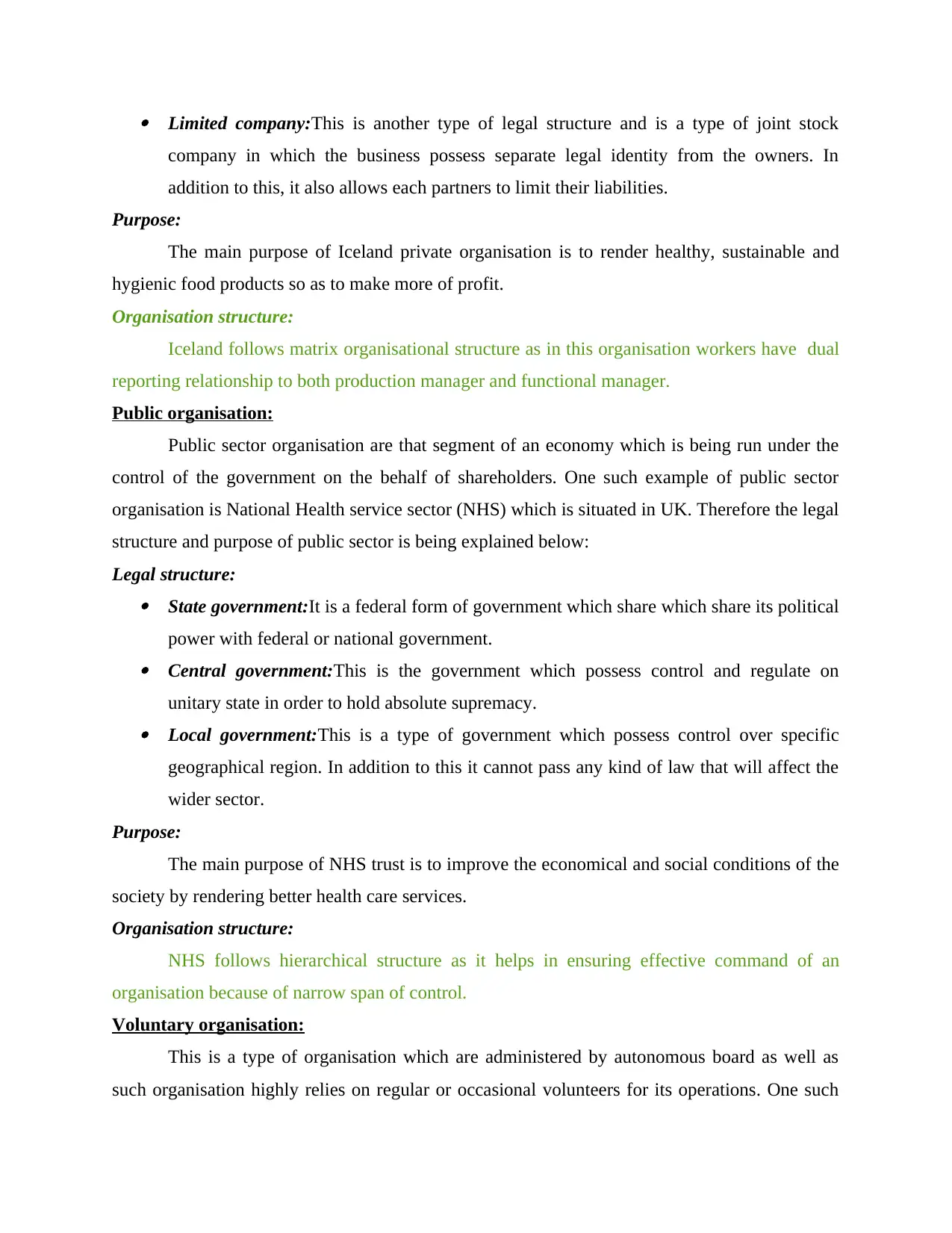
Limited company:This is another type of legal structure and is a type of joint stock
company in which the business possess separate legal identity from the owners. In
addition to this, it also allows each partners to limit their liabilities.
Purpose:
The main purpose of Iceland private organisation is to render healthy, sustainable and
hygienic food products so as to make more of profit.
Organisation structure:
Iceland follows matrix organisational structure as in this organisation workers have dual
reporting relationship to both production manager and functional manager.
Public organisation:
Public sector organisation are that segment of an economy which is being run under the
control of the government on the behalf of shareholders. One such example of public sector
organisation is National Health service sector (NHS) which is situated in UK. Therefore the legal
structure and purpose of public sector is being explained below:
Legal structure: State government:It is a federal form of government which share which share its political
power with federal or national government. Central government:This is the government which possess control and regulate on
unitary state in order to hold absolute supremacy. Local government:This is a type of government which possess control over specific
geographical region. In addition to this it cannot pass any kind of law that will affect the
wider sector.
Purpose:
The main purpose of NHS trust is to improve the economical and social conditions of the
society by rendering better health care services.
Organisation structure:
NHS follows hierarchical structure as it helps in ensuring effective command of an
organisation because of narrow span of control.
Voluntary organisation:
This is a type of organisation which are administered by autonomous board as well as
such organisation highly relies on regular or occasional volunteers for its operations. One such
company in which the business possess separate legal identity from the owners. In
addition to this, it also allows each partners to limit their liabilities.
Purpose:
The main purpose of Iceland private organisation is to render healthy, sustainable and
hygienic food products so as to make more of profit.
Organisation structure:
Iceland follows matrix organisational structure as in this organisation workers have dual
reporting relationship to both production manager and functional manager.
Public organisation:
Public sector organisation are that segment of an economy which is being run under the
control of the government on the behalf of shareholders. One such example of public sector
organisation is National Health service sector (NHS) which is situated in UK. Therefore the legal
structure and purpose of public sector is being explained below:
Legal structure: State government:It is a federal form of government which share which share its political
power with federal or national government. Central government:This is the government which possess control and regulate on
unitary state in order to hold absolute supremacy. Local government:This is a type of government which possess control over specific
geographical region. In addition to this it cannot pass any kind of law that will affect the
wider sector.
Purpose:
The main purpose of NHS trust is to improve the economical and social conditions of the
society by rendering better health care services.
Organisation structure:
NHS follows hierarchical structure as it helps in ensuring effective command of an
organisation because of narrow span of control.
Voluntary organisation:
This is a type of organisation which are administered by autonomous board as well as
such organisation highly relies on regular or occasional volunteers for its operations. One such
Paraphrase This Document
Need a fresh take? Get an instant paraphrase of this document with our AI Paraphraser
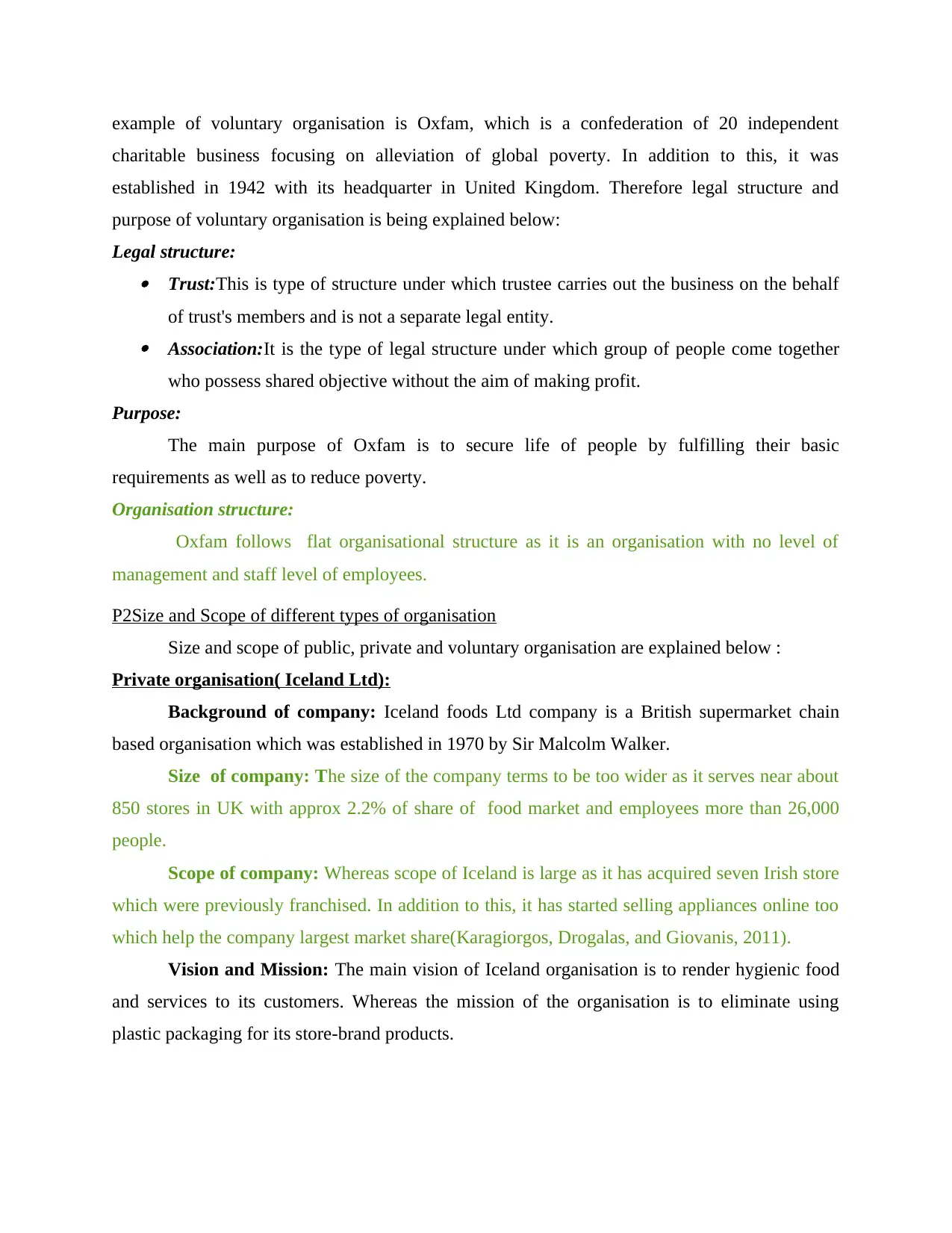
example of voluntary organisation is Oxfam, which is a confederation of 20 independent
charitable business focusing on alleviation of global poverty. In addition to this, it was
established in 1942 with its headquarter in United Kingdom. Therefore legal structure and
purpose of voluntary organisation is being explained below:
Legal structure: Trust:This is type of structure under which trustee carries out the business on the behalf
of trust's members and is not a separate legal entity. Association:It is the type of legal structure under which group of people come together
who possess shared objective without the aim of making profit.
Purpose:
The main purpose of Oxfam is to secure life of people by fulfilling their basic
requirements as well as to reduce poverty.
Organisation structure:
Oxfam follows flat organisational structure as it is an organisation with no level of
management and staff level of employees.
P2Size and Scope of different types of organisation
Size and scope of public, private and voluntary organisation are explained below :
Private organisation( Iceland Ltd):
Background of company: Iceland foods Ltd company is a British supermarket chain
based organisation which was established in 1970 by Sir Malcolm Walker.
Size of company: The size of the company terms to be too wider as it serves near about
850 stores in UK with approx 2.2% of share of food market and employees more than 26,000
people.
Scope of company: Whereas scope of Iceland is large as it has acquired seven Irish store
which were previously franchised. In addition to this, it has started selling appliances online too
which help the company largest market share(Karagiorgos, Drogalas, and Giovanis, 2011).
Vision and Mission: The main vision of Iceland organisation is to render hygienic food
and services to its customers. Whereas the mission of the organisation is to eliminate using
plastic packaging for its store-brand products.
charitable business focusing on alleviation of global poverty. In addition to this, it was
established in 1942 with its headquarter in United Kingdom. Therefore legal structure and
purpose of voluntary organisation is being explained below:
Legal structure: Trust:This is type of structure under which trustee carries out the business on the behalf
of trust's members and is not a separate legal entity. Association:It is the type of legal structure under which group of people come together
who possess shared objective without the aim of making profit.
Purpose:
The main purpose of Oxfam is to secure life of people by fulfilling their basic
requirements as well as to reduce poverty.
Organisation structure:
Oxfam follows flat organisational structure as it is an organisation with no level of
management and staff level of employees.
P2Size and Scope of different types of organisation
Size and scope of public, private and voluntary organisation are explained below :
Private organisation( Iceland Ltd):
Background of company: Iceland foods Ltd company is a British supermarket chain
based organisation which was established in 1970 by Sir Malcolm Walker.
Size of company: The size of the company terms to be too wider as it serves near about
850 stores in UK with approx 2.2% of share of food market and employees more than 26,000
people.
Scope of company: Whereas scope of Iceland is large as it has acquired seven Irish store
which were previously franchised. In addition to this, it has started selling appliances online too
which help the company largest market share(Karagiorgos, Drogalas, and Giovanis, 2011).
Vision and Mission: The main vision of Iceland organisation is to render hygienic food
and services to its customers. Whereas the mission of the organisation is to eliminate using
plastic packaging for its store-brand products.
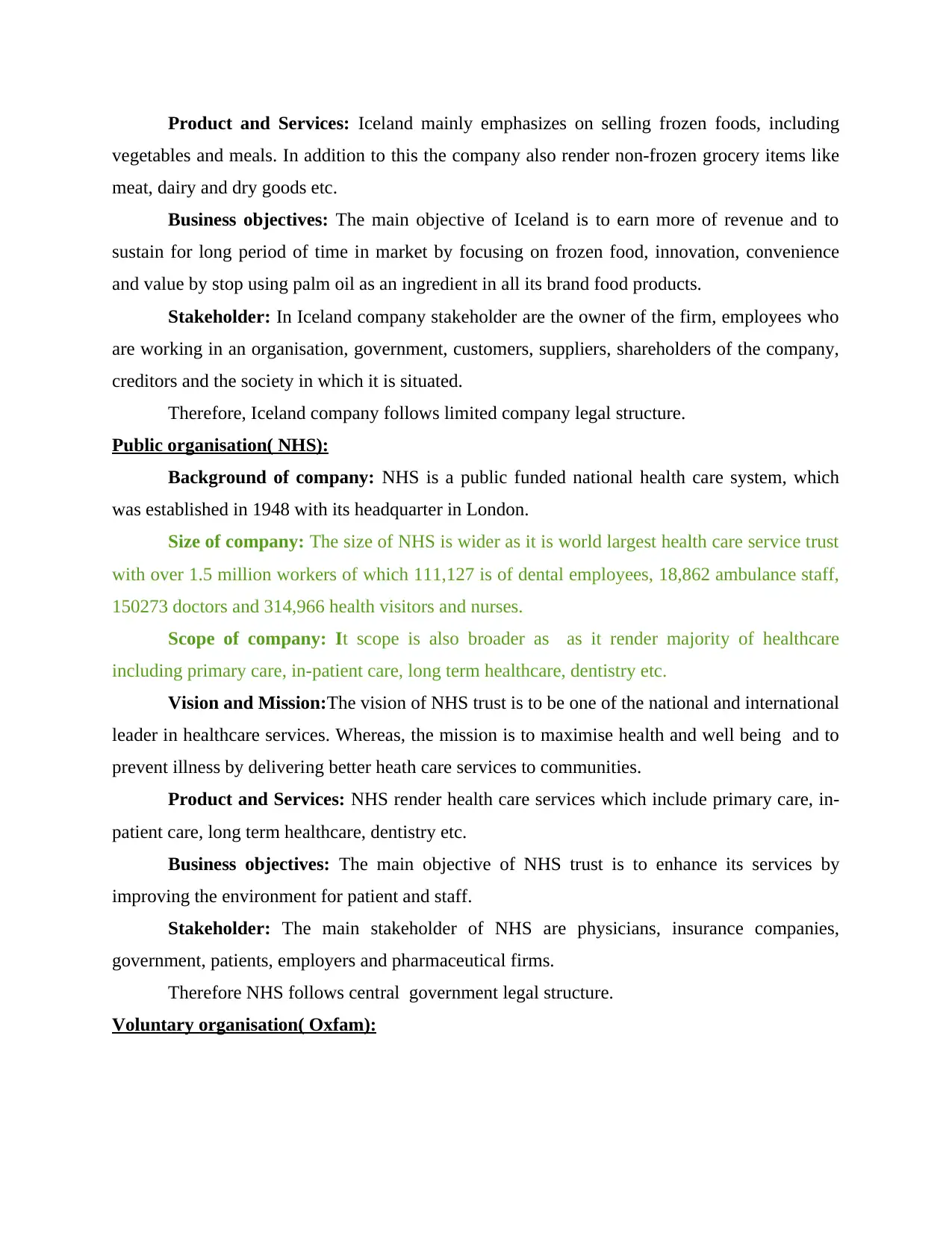
Product and Services: Iceland mainly emphasizes on selling frozen foods, including
vegetables and meals. In addition to this the company also render non-frozen grocery items like
meat, dairy and dry goods etc.
Business objectives: The main objective of Iceland is to earn more of revenue and to
sustain for long period of time in market by focusing on frozen food, innovation, convenience
and value by stop using palm oil as an ingredient in all its brand food products.
Stakeholder: In Iceland company stakeholder are the owner of the firm, employees who
are working in an organisation, government, customers, suppliers, shareholders of the company,
creditors and the society in which it is situated.
Therefore, Iceland company follows limited company legal structure.
Public organisation( NHS):
Background of company: NHS is a public funded national health care system, which
was established in 1948 with its headquarter in London.
Size of company: The size of NHS is wider as it is world largest health care service trust
with over 1.5 million workers of which 111,127 is of dental employees, 18,862 ambulance staff,
150273 doctors and 314,966 health visitors and nurses.
Scope of company: It scope is also broader as as it render majority of healthcare
including primary care, in-patient care, long term healthcare, dentistry etc.
Vision and Mission:The vision of NHS trust is to be one of the national and international
leader in healthcare services. Whereas, the mission is to maximise health and well being and to
prevent illness by delivering better heath care services to communities.
Product and Services: NHS render health care services which include primary care, in-
patient care, long term healthcare, dentistry etc.
Business objectives: The main objective of NHS trust is to enhance its services by
improving the environment for patient and staff.
Stakeholder: The main stakeholder of NHS are physicians, insurance companies,
government, patients, employers and pharmaceutical firms.
Therefore NHS follows central government legal structure.
Voluntary organisation( Oxfam):
vegetables and meals. In addition to this the company also render non-frozen grocery items like
meat, dairy and dry goods etc.
Business objectives: The main objective of Iceland is to earn more of revenue and to
sustain for long period of time in market by focusing on frozen food, innovation, convenience
and value by stop using palm oil as an ingredient in all its brand food products.
Stakeholder: In Iceland company stakeholder are the owner of the firm, employees who
are working in an organisation, government, customers, suppliers, shareholders of the company,
creditors and the society in which it is situated.
Therefore, Iceland company follows limited company legal structure.
Public organisation( NHS):
Background of company: NHS is a public funded national health care system, which
was established in 1948 with its headquarter in London.
Size of company: The size of NHS is wider as it is world largest health care service trust
with over 1.5 million workers of which 111,127 is of dental employees, 18,862 ambulance staff,
150273 doctors and 314,966 health visitors and nurses.
Scope of company: It scope is also broader as as it render majority of healthcare
including primary care, in-patient care, long term healthcare, dentistry etc.
Vision and Mission:The vision of NHS trust is to be one of the national and international
leader in healthcare services. Whereas, the mission is to maximise health and well being and to
prevent illness by delivering better heath care services to communities.
Product and Services: NHS render health care services which include primary care, in-
patient care, long term healthcare, dentistry etc.
Business objectives: The main objective of NHS trust is to enhance its services by
improving the environment for patient and staff.
Stakeholder: The main stakeholder of NHS are physicians, insurance companies,
government, patients, employers and pharmaceutical firms.
Therefore NHS follows central government legal structure.
Voluntary organisation( Oxfam):
⊘ This is a preview!⊘
Do you want full access?
Subscribe today to unlock all pages.

Trusted by 1+ million students worldwide
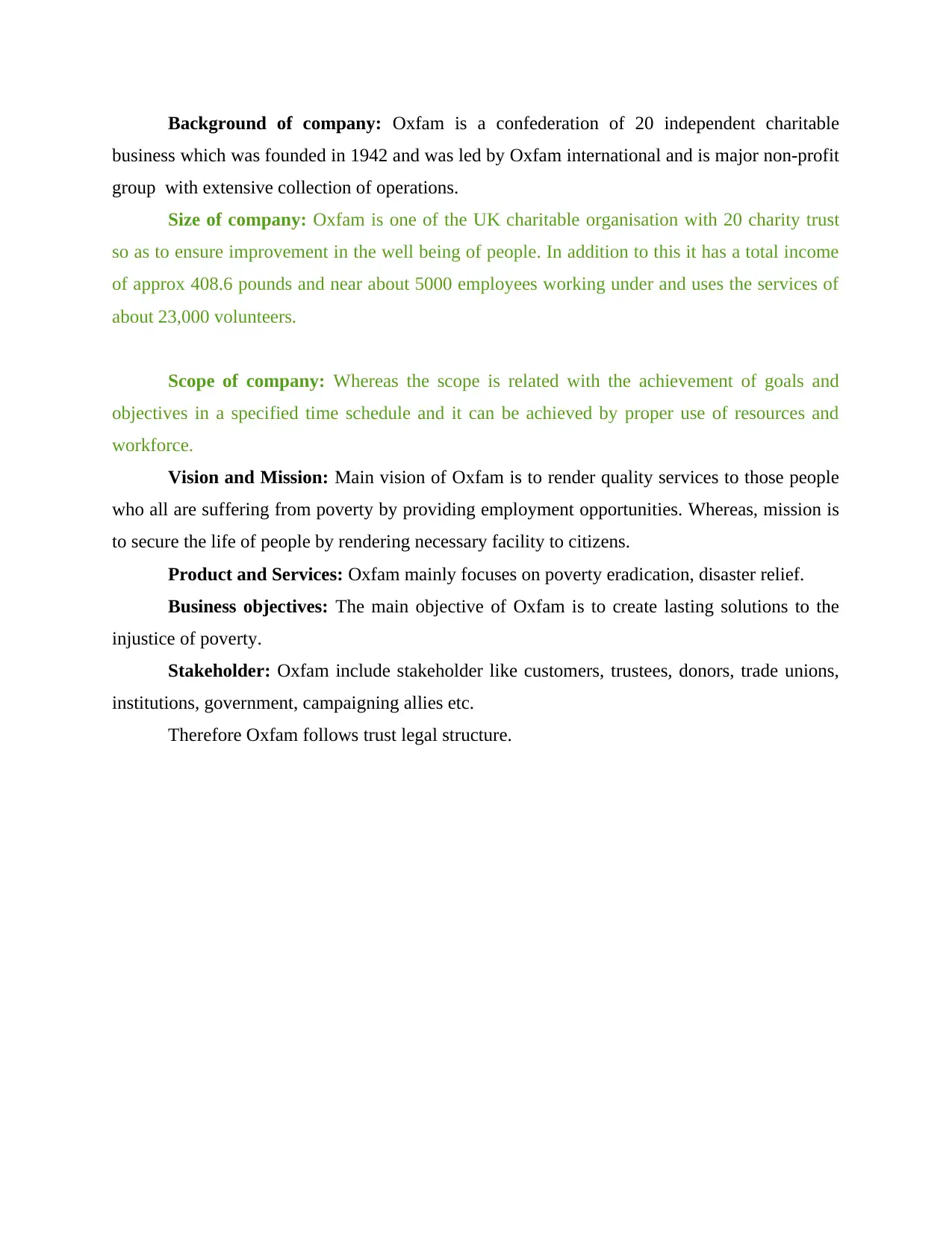
Background of company: Oxfam is a confederation of 20 independent charitable
business which was founded in 1942 and was led by Oxfam international and is major non-profit
group with extensive collection of operations.
Size of company: Oxfam is one of the UK charitable organisation with 20 charity trust
so as to ensure improvement in the well being of people. In addition to this it has a total income
of approx 408.6 pounds and near about 5000 employees working under and uses the services of
about 23,000 volunteers.
Scope of company: Whereas the scope is related with the achievement of goals and
objectives in a specified time schedule and it can be achieved by proper use of resources and
workforce.
Vision and Mission: Main vision of Oxfam is to render quality services to those people
who all are suffering from poverty by providing employment opportunities. Whereas, mission is
to secure the life of people by rendering necessary facility to citizens.
Product and Services: Oxfam mainly focuses on poverty eradication, disaster relief.
Business objectives: The main objective of Oxfam is to create lasting solutions to the
injustice of poverty.
Stakeholder: Oxfam include stakeholder like customers, trustees, donors, trade unions,
institutions, government, campaigning allies etc.
Therefore Oxfam follows trust legal structure.
business which was founded in 1942 and was led by Oxfam international and is major non-profit
group with extensive collection of operations.
Size of company: Oxfam is one of the UK charitable organisation with 20 charity trust
so as to ensure improvement in the well being of people. In addition to this it has a total income
of approx 408.6 pounds and near about 5000 employees working under and uses the services of
about 23,000 volunteers.
Scope of company: Whereas the scope is related with the achievement of goals and
objectives in a specified time schedule and it can be achieved by proper use of resources and
workforce.
Vision and Mission: Main vision of Oxfam is to render quality services to those people
who all are suffering from poverty by providing employment opportunities. Whereas, mission is
to secure the life of people by rendering necessary facility to citizens.
Product and Services: Oxfam mainly focuses on poverty eradication, disaster relief.
Business objectives: The main objective of Oxfam is to create lasting solutions to the
injustice of poverty.
Stakeholder: Oxfam include stakeholder like customers, trustees, donors, trade unions,
institutions, government, campaigning allies etc.
Therefore Oxfam follows trust legal structure.
Paraphrase This Document
Need a fresh take? Get an instant paraphrase of this document with our AI Paraphraser

TASK 2
P3 Relationship between different organisation function
Illustration 1: Organisational structure of Icelant Limited
In order to run specific organisation in an appropriate manner, various functional
activities are needed to be carried out and each functional activity are related to each other.
Therefore relationship of different organisation functions of Iceland are being explained below
(Osterwalder and Pigneur, 2010):
Finance and marketing department:
Finance department of Iceland is the one who will render funds in organisation in order to
carry out different operational activity successfully. Marketing department is the main
department of an organisation who helps in creating awareness about the products in the
marketplace to large number of customers. So in order to create awareness about product through
different medium channels, like TV radio, newspaper, magazines etc. marketing department will
require sufficient amount of funds which will be rendered by the finance department. As the
Iceland company follows matrix organisational structure because of which communication
among marketing and finance department takes place effectively without the interference and
P3 Relationship between different organisation function
Illustration 1: Organisational structure of Icelant Limited
In order to run specific organisation in an appropriate manner, various functional
activities are needed to be carried out and each functional activity are related to each other.
Therefore relationship of different organisation functions of Iceland are being explained below
(Osterwalder and Pigneur, 2010):
Finance and marketing department:
Finance department of Iceland is the one who will render funds in organisation in order to
carry out different operational activity successfully. Marketing department is the main
department of an organisation who helps in creating awareness about the products in the
marketplace to large number of customers. So in order to create awareness about product through
different medium channels, like TV radio, newspaper, magazines etc. marketing department will
require sufficient amount of funds which will be rendered by the finance department. As the
Iceland company follows matrix organisational structure because of which communication
among marketing and finance department takes place effectively without the interference and
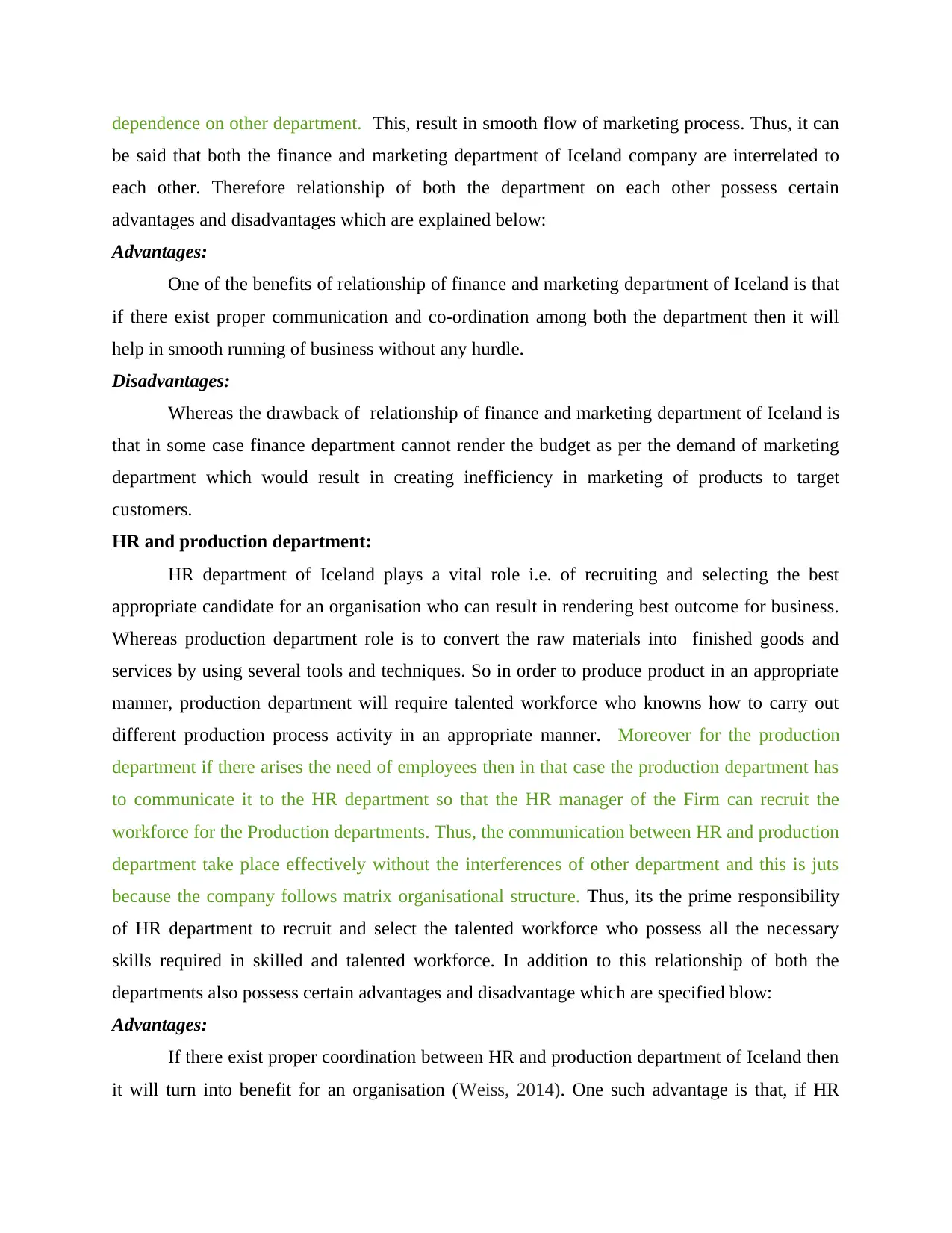
dependence on other department. This, result in smooth flow of marketing process. Thus, it can
be said that both the finance and marketing department of Iceland company are interrelated to
each other. Therefore relationship of both the department on each other possess certain
advantages and disadvantages which are explained below:
Advantages:
One of the benefits of relationship of finance and marketing department of Iceland is that
if there exist proper communication and co-ordination among both the department then it will
help in smooth running of business without any hurdle.
Disadvantages:
Whereas the drawback of relationship of finance and marketing department of Iceland is
that in some case finance department cannot render the budget as per the demand of marketing
department which would result in creating inefficiency in marketing of products to target
customers.
HR and production department:
HR department of Iceland plays a vital role i.e. of recruiting and selecting the best
appropriate candidate for an organisation who can result in rendering best outcome for business.
Whereas production department role is to convert the raw materials into finished goods and
services by using several tools and techniques. So in order to produce product in an appropriate
manner, production department will require talented workforce who knowns how to carry out
different production process activity in an appropriate manner. Moreover for the production
department if there arises the need of employees then in that case the production department has
to communicate it to the HR department so that the HR manager of the Firm can recruit the
workforce for the Production departments. Thus, the communication between HR and production
department take place effectively without the interferences of other department and this is juts
because the company follows matrix organisational structure. Thus, its the prime responsibility
of HR department to recruit and select the talented workforce who possess all the necessary
skills required in skilled and talented workforce. In addition to this relationship of both the
departments also possess certain advantages and disadvantage which are specified blow:
Advantages:
If there exist proper coordination between HR and production department of Iceland then
it will turn into benefit for an organisation (Weiss, 2014). One such advantage is that, if HR
be said that both the finance and marketing department of Iceland company are interrelated to
each other. Therefore relationship of both the department on each other possess certain
advantages and disadvantages which are explained below:
Advantages:
One of the benefits of relationship of finance and marketing department of Iceland is that
if there exist proper communication and co-ordination among both the department then it will
help in smooth running of business without any hurdle.
Disadvantages:
Whereas the drawback of relationship of finance and marketing department of Iceland is
that in some case finance department cannot render the budget as per the demand of marketing
department which would result in creating inefficiency in marketing of products to target
customers.
HR and production department:
HR department of Iceland plays a vital role i.e. of recruiting and selecting the best
appropriate candidate for an organisation who can result in rendering best outcome for business.
Whereas production department role is to convert the raw materials into finished goods and
services by using several tools and techniques. So in order to produce product in an appropriate
manner, production department will require talented workforce who knowns how to carry out
different production process activity in an appropriate manner. Moreover for the production
department if there arises the need of employees then in that case the production department has
to communicate it to the HR department so that the HR manager of the Firm can recruit the
workforce for the Production departments. Thus, the communication between HR and production
department take place effectively without the interferences of other department and this is juts
because the company follows matrix organisational structure. Thus, its the prime responsibility
of HR department to recruit and select the talented workforce who possess all the necessary
skills required in skilled and talented workforce. In addition to this relationship of both the
departments also possess certain advantages and disadvantage which are specified blow:
Advantages:
If there exist proper coordination between HR and production department of Iceland then
it will turn into benefit for an organisation (Weiss, 2014). One such advantage is that, if HR
⊘ This is a preview!⊘
Do you want full access?
Subscribe today to unlock all pages.

Trusted by 1+ million students worldwide
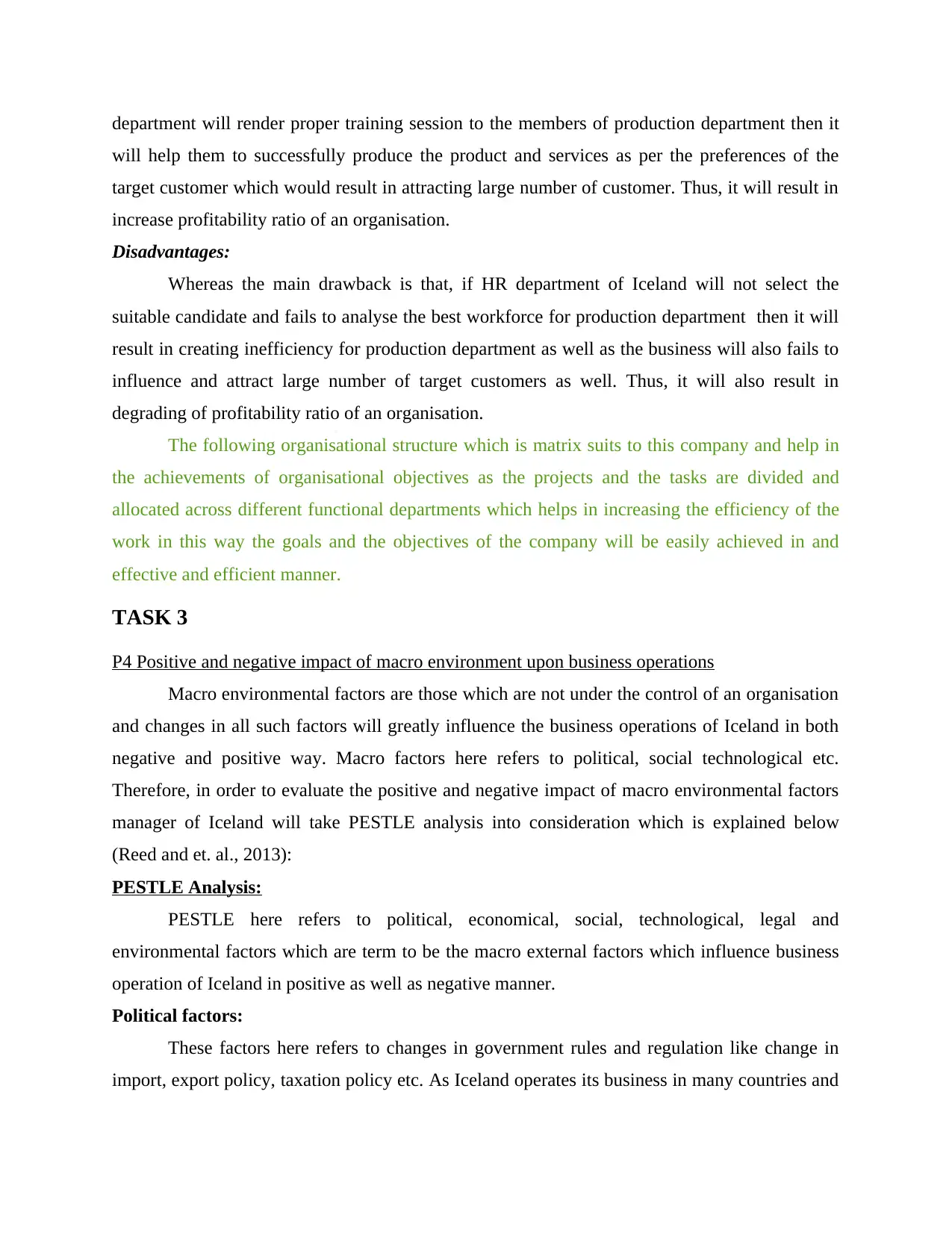
department will render proper training session to the members of production department then it
will help them to successfully produce the product and services as per the preferences of the
target customer which would result in attracting large number of customer. Thus, it will result in
increase profitability ratio of an organisation.
Disadvantages:
Whereas the main drawback is that, if HR department of Iceland will not select the
suitable candidate and fails to analyse the best workforce for production department then it will
result in creating inefficiency for production department as well as the business will also fails to
influence and attract large number of target customers as well. Thus, it will also result in
degrading of profitability ratio of an organisation.
The following organisational structure which is matrix suits to this company and help in
the achievements of organisational objectives as the projects and the tasks are divided and
allocated across different functional departments which helps in increasing the efficiency of the
work in this way the goals and the objectives of the company will be easily achieved in and
effective and efficient manner.
TASK 3
P4 Positive and negative impact of macro environment upon business operations
Macro environmental factors are those which are not under the control of an organisation
and changes in all such factors will greatly influence the business operations of Iceland in both
negative and positive way. Macro factors here refers to political, social technological etc.
Therefore, in order to evaluate the positive and negative impact of macro environmental factors
manager of Iceland will take PESTLE analysis into consideration which is explained below
(Reed and et. al., 2013):
PESTLE Analysis:
PESTLE here refers to political, economical, social, technological, legal and
environmental factors which are term to be the macro external factors which influence business
operation of Iceland in positive as well as negative manner.
Political factors:
These factors here refers to changes in government rules and regulation like change in
import, export policy, taxation policy etc. As Iceland operates its business in many countries and
will help them to successfully produce the product and services as per the preferences of the
target customer which would result in attracting large number of customer. Thus, it will result in
increase profitability ratio of an organisation.
Disadvantages:
Whereas the main drawback is that, if HR department of Iceland will not select the
suitable candidate and fails to analyse the best workforce for production department then it will
result in creating inefficiency for production department as well as the business will also fails to
influence and attract large number of target customers as well. Thus, it will also result in
degrading of profitability ratio of an organisation.
The following organisational structure which is matrix suits to this company and help in
the achievements of organisational objectives as the projects and the tasks are divided and
allocated across different functional departments which helps in increasing the efficiency of the
work in this way the goals and the objectives of the company will be easily achieved in and
effective and efficient manner.
TASK 3
P4 Positive and negative impact of macro environment upon business operations
Macro environmental factors are those which are not under the control of an organisation
and changes in all such factors will greatly influence the business operations of Iceland in both
negative and positive way. Macro factors here refers to political, social technological etc.
Therefore, in order to evaluate the positive and negative impact of macro environmental factors
manager of Iceland will take PESTLE analysis into consideration which is explained below
(Reed and et. al., 2013):
PESTLE Analysis:
PESTLE here refers to political, economical, social, technological, legal and
environmental factors which are term to be the macro external factors which influence business
operation of Iceland in positive as well as negative manner.
Political factors:
These factors here refers to changes in government rules and regulation like change in
import, export policy, taxation policy etc. As Iceland operates its business in many countries and
Paraphrase This Document
Need a fresh take? Get an instant paraphrase of this document with our AI Paraphraser

each country have different rules and regulation, so it is very much essential for the manager of
Iceland to analysis of changes taking place in political factors (Hunter, Saunders and Constance,
2016). For example: In UK, political scenario is balanced and supportive to business, with
strong legislation to business entities or opportunities. Iceland is the bigger example of this
strong political stability along with legislations to strengthen the business.
Positive Impact - If the management of Iceland will take changes into consideration flexibly then
it will have positive impact on organisation by the way of strengthening the position of company
as well as will also helps in creating expansion opportunities for an organisation (Kew, and
Stredwick, 2017).
Negative impact - If the company will not consider changes taking place in the government
rules and regulation then it will negatively impact an organisation as it will result in decrease in
sales revenue of an organisation due to decrease in buying power of targeted customers.
Economical factors:
These factors refers to the changes taking place in deflation and inflation rate, foreign
exchange rate system etc. Therefore changes in all these economical factors greatly influence the
business operations of Iceland in both positive as well as negative manner. So, it is very much
essential for the manager of Iceland to frame polices and strategies taking changes taking place
in inflation rate, deflation rate, level of income etc. For example: Pounds sterling is relatively
less valued in comparison to Dollar (Zur Muehlen and Shapiro, 2015). Because of this, currency
crash down, Iceland ability to import has decreased. Also, rise in raw material prices is also
major influences of it.
Positive Impact - If the company will adopts all such changes and will frame polices accordingly
then it will positively impact upon business operation by increasing the productivity of an
organisation (Halbert and Ingulli, 2011).
Negative impact - In case if the currency value is low of the country in which the company is
operating as compared to organisation value then it will negatively result in down falling of
company in marketplace.
Social factors:
These factors here refers to the changes taking place in the customers beliefs behaviour
and values which will greatly impact in both positive as well as negative manner on the business
operations of Iceland. For example: Iceland has faced social impact such as social or cultural
Iceland to analysis of changes taking place in political factors (Hunter, Saunders and Constance,
2016). For example: In UK, political scenario is balanced and supportive to business, with
strong legislation to business entities or opportunities. Iceland is the bigger example of this
strong political stability along with legislations to strengthen the business.
Positive Impact - If the management of Iceland will take changes into consideration flexibly then
it will have positive impact on organisation by the way of strengthening the position of company
as well as will also helps in creating expansion opportunities for an organisation (Kew, and
Stredwick, 2017).
Negative impact - If the company will not consider changes taking place in the government
rules and regulation then it will negatively impact an organisation as it will result in decrease in
sales revenue of an organisation due to decrease in buying power of targeted customers.
Economical factors:
These factors refers to the changes taking place in deflation and inflation rate, foreign
exchange rate system etc. Therefore changes in all these economical factors greatly influence the
business operations of Iceland in both positive as well as negative manner. So, it is very much
essential for the manager of Iceland to frame polices and strategies taking changes taking place
in inflation rate, deflation rate, level of income etc. For example: Pounds sterling is relatively
less valued in comparison to Dollar (Zur Muehlen and Shapiro, 2015). Because of this, currency
crash down, Iceland ability to import has decreased. Also, rise in raw material prices is also
major influences of it.
Positive Impact - If the company will adopts all such changes and will frame polices accordingly
then it will positively impact upon business operation by increasing the productivity of an
organisation (Halbert and Ingulli, 2011).
Negative impact - In case if the currency value is low of the country in which the company is
operating as compared to organisation value then it will negatively result in down falling of
company in marketplace.
Social factors:
These factors here refers to the changes taking place in the customers beliefs behaviour
and values which will greatly impact in both positive as well as negative manner on the business
operations of Iceland. For example: Iceland has faced social impact such as social or cultural
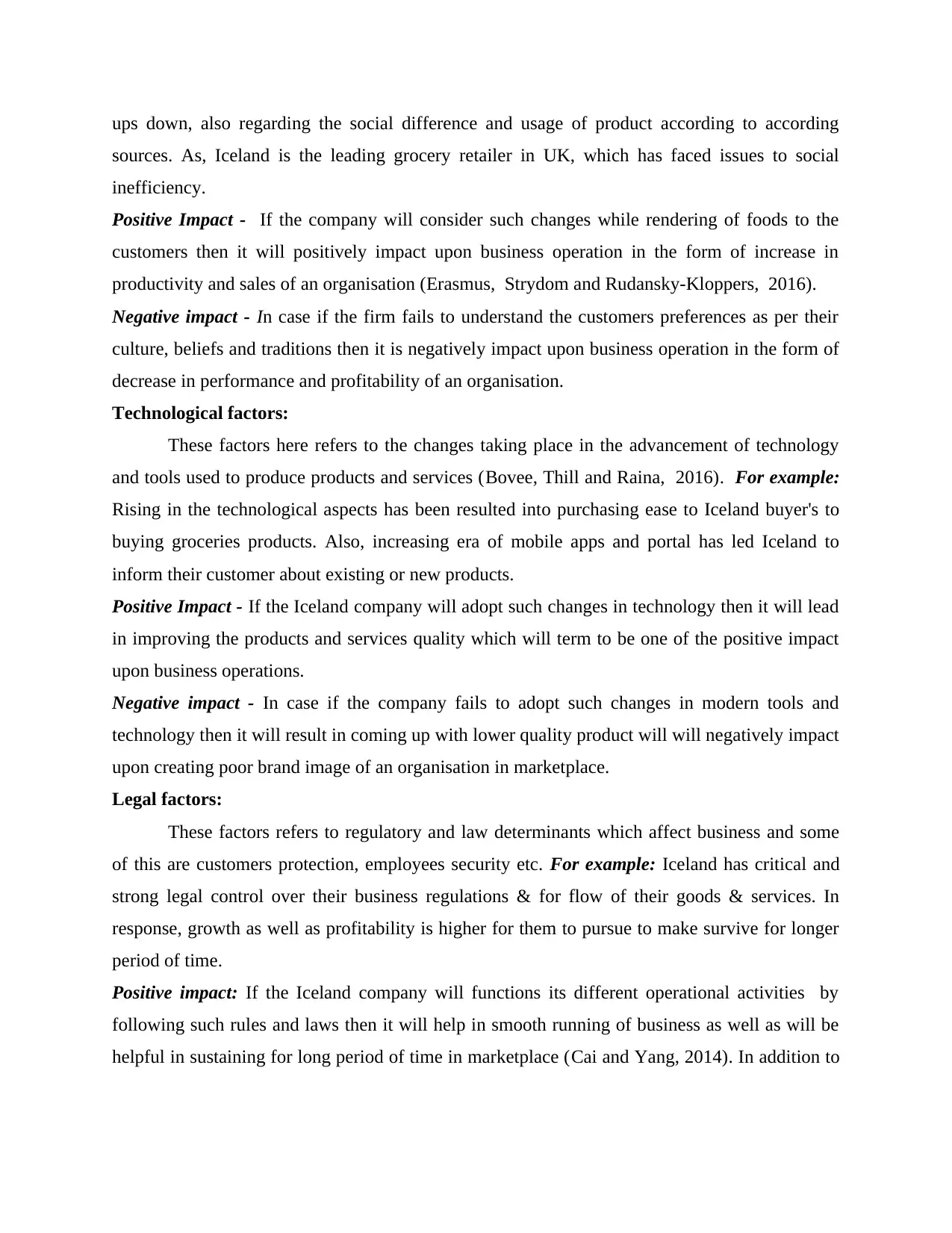
ups down, also regarding the social difference and usage of product according to according
sources. As, Iceland is the leading grocery retailer in UK, which has faced issues to social
inefficiency.
Positive Impact - If the company will consider such changes while rendering of foods to the
customers then it will positively impact upon business operation in the form of increase in
productivity and sales of an organisation (Erasmus, Strydom and Rudansky-Kloppers, 2016).
Negative impact - In case if the firm fails to understand the customers preferences as per their
culture, beliefs and traditions then it is negatively impact upon business operation in the form of
decrease in performance and profitability of an organisation.
Technological factors:
These factors here refers to the changes taking place in the advancement of technology
and tools used to produce products and services (Bovee, Thill and Raina, 2016). For example:
Rising in the technological aspects has been resulted into purchasing ease to Iceland buyer's to
buying groceries products. Also, increasing era of mobile apps and portal has led Iceland to
inform their customer about existing or new products.
Positive Impact - If the Iceland company will adopt such changes in technology then it will lead
in improving the products and services quality which will term to be one of the positive impact
upon business operations.
Negative impact - In case if the company fails to adopt such changes in modern tools and
technology then it will result in coming up with lower quality product will will negatively impact
upon creating poor brand image of an organisation in marketplace.
Legal factors:
These factors refers to regulatory and law determinants which affect business and some
of this are customers protection, employees security etc. For example: Iceland has critical and
strong legal control over their business regulations & for flow of their goods & services. In
response, growth as well as profitability is higher for them to pursue to make survive for longer
period of time.
Positive impact: If the Iceland company will functions its different operational activities by
following such rules and laws then it will help in smooth running of business as well as will be
helpful in sustaining for long period of time in marketplace (Cai and Yang, 2014). In addition to
sources. As, Iceland is the leading grocery retailer in UK, which has faced issues to social
inefficiency.
Positive Impact - If the company will consider such changes while rendering of foods to the
customers then it will positively impact upon business operation in the form of increase in
productivity and sales of an organisation (Erasmus, Strydom and Rudansky-Kloppers, 2016).
Negative impact - In case if the firm fails to understand the customers preferences as per their
culture, beliefs and traditions then it is negatively impact upon business operation in the form of
decrease in performance and profitability of an organisation.
Technological factors:
These factors here refers to the changes taking place in the advancement of technology
and tools used to produce products and services (Bovee, Thill and Raina, 2016). For example:
Rising in the technological aspects has been resulted into purchasing ease to Iceland buyer's to
buying groceries products. Also, increasing era of mobile apps and portal has led Iceland to
inform their customer about existing or new products.
Positive Impact - If the Iceland company will adopt such changes in technology then it will lead
in improving the products and services quality which will term to be one of the positive impact
upon business operations.
Negative impact - In case if the company fails to adopt such changes in modern tools and
technology then it will result in coming up with lower quality product will will negatively impact
upon creating poor brand image of an organisation in marketplace.
Legal factors:
These factors refers to regulatory and law determinants which affect business and some
of this are customers protection, employees security etc. For example: Iceland has critical and
strong legal control over their business regulations & for flow of their goods & services. In
response, growth as well as profitability is higher for them to pursue to make survive for longer
period of time.
Positive impact: If the Iceland company will functions its different operational activities by
following such rules and laws then it will help in smooth running of business as well as will be
helpful in sustaining for long period of time in marketplace (Cai and Yang, 2014). In addition to
⊘ This is a preview!⊘
Do you want full access?
Subscribe today to unlock all pages.

Trusted by 1+ million students worldwide
1 out of 18
Related Documents
Your All-in-One AI-Powered Toolkit for Academic Success.
+13062052269
info@desklib.com
Available 24*7 on WhatsApp / Email
![[object Object]](/_next/static/media/star-bottom.7253800d.svg)
Unlock your academic potential
Copyright © 2020–2025 A2Z Services. All Rights Reserved. Developed and managed by ZUCOL.




